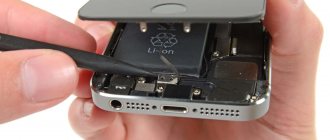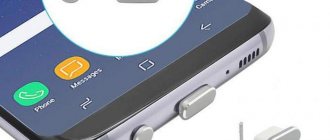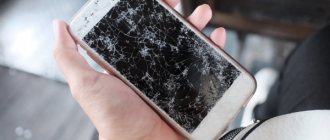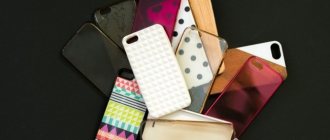Share on social media networks:
It's hard to believe now that mobile devices were the easiest way to connect with other people. Now an ordinary mobile phone has turned into a high-speed smartphone with enormous multimedia functionality, and the case has begun to store the power of a good computer inside it. Using devices is very addictive and some people don’t even take a break for at least a short time. This kind of use takes a toll on charging, and constant recharging can damage one of the phone's most important connectors. You will learn how to fix the phone charging socket if it is broken in today's article.
The charging connector on the phone is broken - charge directly
If you don't know how to change the charging socket on your phone, you can try to recharge the battery without having to use the power socket. The method is relatively complex and requires some skills in working with electricity. The point is this:
- You need to remove the battery from your phone.
- Cut off the insulation from the charger wire, expose the wires (unplug from the outlet).
- Strip the veins, determine where the plus and minus are.
- Find the corresponding terminals on the cell phone battery. It is important to observe the polarity of the wires and the device.
- Secure the wires and plug the plug into the socket.
It is strongly not recommended to use this method if you are not 100% confident in your skills. You should not carry out manipulations when you are alone at home; there must be a person nearby who could help you in case of a possible electric shock. Please note that this connection option is not normal for the battery and can lead to breakdown or premature depletion.
Night sweats - causes in men, as a symptom of disease. Why cabbage is good for the body. Beneficial properties of cabbage and contraindications Ketone bodies in urine - what does this mean: causes and treatment
Is it possible to unsolder the socket with a soldering iron and how to do it
We found out how to replace the connector using a hair dryer. With some practice and care this will not be difficult to do. But how to replace the connector if you don’t have a soldering gun? After all, not every one of us does soldering, and buying a hair dryer for one time is somehow stupid. Well, if you don’t have a hair dryer, you can repair your smartphone using a regular soldering iron.
We place a flat tip on the soldering iron, and while it is warming up (the tip, of course, is already tinned - ready for work), we apply soldering flux to the fixing legs, the connector itself and its contacts.
Our task is to increase the heat capacity of the socket body, to dilute the refractory lead-free solder, which manufacturers use for soldering, with less refractory tin-lead solder. Take a soldering iron and apply solder.
Now we begin to warm the body while shaking it with tweezers. In just 5–10 seconds the solder will melt and the connector can be removed.
We remove excess solder from the mounting holes and contact pads. Apply soldering flux again.
We take the braid and quickly solder the contact and mounting pads through it. The solder was successfully absorbed into the braid, not only ours, but also the refractory solder that the socket was soldered with at the factory.
Using Galosh gasoline or alcohol, we clean the contacts from used flux. It is convenient to use a cotton swab for this.
Important! If there is a camera, microphone or similar components near the place where we will wash, be sure to seal them with regular tape so that solder does not get into the devices, which will damage them.
We inspect the contacts for breaks or short circuits. Installing a new connector. Using a magnifying glass, we make sure that all the pins are on their contact pads on the board.
All that remains is to solder the mounting and interface contacts. Let's start with the editing rooms. We apply flux and solder each of them using lead-tin solder.
Now interface. We apply soldering flux to them and solder each of them with a thin tip. Those with good eyesight can even do it without a magnifying glass.
We take the “Galosh” again and wash off the remaining flux with a cotton swab. Using a magnifying glass, carefully inspect the contacts for missing connections or soldering of adjacent contacts. If necessary, apply flux again and repeat the operation. Soldered contacts can be easily separated by passing a tip between them. We assemble the gadget, connect the charger, and make sure that everything works fine. At this point the replacement process can be considered complete.
Important! After replacing the connector, be sure to connect the smartphone to the PC and make sure that the gadget is recognized by the computer as an external drive.
We charge the device directly
How to fix the phone charging connector? You can try to replenish your energy reserves by disconnecting the power port itself from the phone.
Important! This method is very complex and requires the user to have basic knowledge and skills in working with equipment and electricity.
The essence of the work is as follows:
- We remove the battery from the smartphone.
- We unplug the charger from the outlet, arm ourselves with a sharp object and remove the insulation from the wire about five centimeters.
- Strip the wires and determine where the plus is and where the minus is.
- Determine the polarities on the battery and connect the wires to it.
- Fix the improvised terminals and supply power from the network.
Important! It is not recommended to resort to this method, since you may get hurt even while charging. Do not work with wires without insulation if you have never done this before and do not know how electric current behaves.
How to choose a service center
It is best to give the phone to a branded service of the same brand as the device. Maintenance certificates are required. View reviews of the selected service on the website.
Initially, a mobile phone was a simple device for making calls. Now it is a multifunctional device, without which a person will not be so comfortable. If used carelessly, the power socket sometimes breaks. In this case, you should know how to repair the phone's charging connector or charge it in another way.
Causes and temporary solutions
The reason may be contamination of the internal space of the connector - dust, leakage of dirty liquid, etc. In this case, you can try to clean the nest with a sharpened toothpick or match. You should not try to use a metal object - you may damage the contacts or plastic structural elements of the connector. Another option is to blow out the hole with compressed air (for example, from a can). You can use a vacuum cleaner, but the cleaning efficiency will be much lower.
It would not be the best option to try to wash the connector with a solvent (if it is not pure ethyl alcohol). Other compositions can dissolve not only dirt, but also plastic parts of the connector, as well as parts of the phone case if it gets on them, as well as other polymer structures inside the smartphone if they flow under the case. In addition, many solvents, after evaporation, can leave a film that disrupts contact. Therefore, this may be a last resort option when there are no alternatives left.
Another reason is a violation of the nest design.
Connector design.
It consists of a contact part and an outer shell, which is made of a fairly plastic material. This shell guides the inserted plug correctly so that the contacts of both parts of the connector match. If used incorrectly - applying excessive lateral forces - the metal is deformed (stretched), the plug fits freely into the socket, its position is not accurately fixed, and it is impossible to match the contacts of the plug and socket. Repairing the mobile phone charging socket in this case is almost impossible. It will not be possible to straighten the shape of the shell due to its small size and the need for high precision impact. Therefore, we must try to find a position where the contacts still coincide. If a position is found, it must be fixed. You may need foreign objects or tape for this. It is better not to touch the gadget until the end of charging.
Is it possible to repair the charging module socket?
How to fix the charging port on your phone at home? You need to figure this out thoroughly, then everything will work out. Careless use of a mobile device very often ends in some kind of breakdown that needs to be fixed. Sometimes the breakdown lies in the connector for connecting the power cable. In this case, you need to find out how to fix it, and for this you should familiarize yourself with the main causes of the defect.
The main reasons for device socket failure:
- You can spill some liquid on the device or simply drop it thoroughly to disable this module.
- Constant mechanical stress deforms the socket, which can make charging the gadget simply impossible - the plug will not fit into the connector or will dangle in it, in which case the socket will need to be replaced.
- The contact pads may also bend, which will completely block access to electricity.
Let's talk right away about the worst thing - moisture.
Contact of a mobile phone connector with moisture is the most dangerous damage. Corrosion will start a chain reaction and all neighboring components will oxidize. This kind of defect can also damage the speaker, which is most often located in the lower part of the device. Also, the speaker itself allows moisture to enter the cable or connector. Therefore, even light rain can damage your phone.
Important! Find out what can be done, whether it is possible to revive the gadget if a more serious problem befalls you - the phone fell into the water and does not turn on.
The most important thing is to assess the complexity of the damage, since not all cases allow for home repairs. The best option is to use the services of a qualified specialist from a service center. This way you won’t risk breaking your device.
Is it possible to repair the device at home?
Very rarely restoration work can be carried out independently. It is best to find an alternative charging method for a while until you decide for yourself whether to repair it yourself. While you are saving the necessary amount for repairs in the workshop, read the instructions for charging a phone with a broken socket:
- Insert the charger into your smartphone and plug it into the network.
Important! This method is only relevant for devices that have suffered from mechanical stress, and not from moisture.
- Carefully move the cord and device in different directions. You may be able to close the contact and charge the device.
- If the mobile phone nevertheless detects the presence of a charger, then it is worth recording the found position. Books and other items can be used that can install the phone so that the power continues.
- Before carrying out all these actions, you should make sure that the problem is in the socket and not in the battery. Using your phone for a long time causes it to no longer hold a charge. In this case, you will have to get a new battery rather than deal with a “phantom” breakdown.
- If the problem is still in the nest, then repairs cannot be avoided. If the socket is moving away from the tablet or the USB input is loose, try changing the socket itself or replacing the cable.
Important! Remember that all these manipulations can further loosen the socket, so do not use too much force during the work.
If everything is fine with the connector now, but the problem of lack of energy in the battery still does not disappear, read about what to do if the phone does not charge when charging.
Using the universal “frog”
You can charge the battery without using a charger. There are special “frogs” - universal devices that plug into the network and are capable of charging batteries. The cost of such a device is quite high, so it will be easier and cheaper to take the smartphone for repair. But if the situation is critical, or you or your friends/neighbors have such a thing, then you can try to use it to charge your phone. But pay attention to several disadvantages of using this method:
- High cost of the device.
- While the battery is removed and charging, you will not be able to use the gadget.
- If used incorrectly or using a low-quality model, there is a possibility of damage to the battery.
Why won't my iPhone charge?
I recently had problems with my iPhone 12. When connected to power, it did not always charge (when using the original cable and adapter). I tried a different cable and charger - same thing. And I decided to look inside the Lightning connector with a flashlight.
Even with the naked eye it was clear that the port was clogged with pocket lint, dust and other dirt. This debris accumulated over time, and I found myself pressing it against the back of the port every time I plugged in the charging cable. Eventually, a small "wall of dirt" began to prevent the charging cable from properly connecting to the pins inside the port. Hence the problems with charging.
An example of how much dirt can be in the iPhone charging socket
So before you spend a lot of time and money fixing iPhone charging problems, try cleaning the port of dirt and other foreign objects. But at the same time, be careful, because when cleaning you can easily make a mistake, due to which repairs may be needed in the future.
If the tracks are broken
Often the conductive paths or contact pads under the connector are broken. This can happen both during operation of the part and during dismantling. In the first case, the tracks come off in attempts to “find contact” by pulling the plug in the socket. In the second - in case of underheating (the pads break off along with the connector) or overheating (the foil simply flies off the textolite substrate).
Torn tracks and pads
Restoring broken tracks
How to be in this case? Most often, the problem can be solved using a soldering iron with a thin tip and a single-core wire with a diameter of 0.2 mm (see the “Consumables” section). We strip the installation wire and extract one core from it. We service it carefully. We install the new connector with a hairdryer or soldering iron. Then solder one end of the wire to the socket contact, and the other to the place closest to the break. Here we are lucky - there are spots nearby that are easy to solder to. If they are not there, then you will have to clean the torn tracks from the varnish, tin them and solder to them. A little more complicated, but also possible.
We wash the “Galoshes” and study our work. If everything is visually beautiful, then we strengthen the nest with compound. Apply it from a syringe and heat it with a hairdryer for a minute at 180 degrees. The compound will strengthen the entire structure, since several contacts practically do not hold onto anything, which means the connector will have play.
Strengthening connector contacts with compound
Expert opinion
Alexey Bartosh
Specialist in repair and maintenance of electrical equipment and industrial electronics.
Ask a Question
Healthy! If you need to dismantle the connector, the compound can be easily removed by heating it with the same hairdryer at a temperature of 300 degrees Celsius.
Types of connectors and their differences
Finding a new charging connector can take a lot of time, and the reason here is not only long delivery times, but also the fact that today there are already many types of connectors that one or another manufacturer uses in their devices.
It would seem, what is the problem? Nowadays, the most popular connectors for phones, smartphones, and tablets are microUSB and USB type-C (type-C). Let's talk about them. The socket broke, I looked to see which one was installed, typed it into a search engine, and ordered it. But the trouble is that there are many dozens of microUSBs alone, varying in design and type of fastening. The photo below shows 12 sockets, all of them microUSB.
These are all microUSB, although they differ significantly from each other in design and mounting
But if you go to the same Ali, you can see a completely bleak picture:
100 (one hundred!) most popular microUSB connectors
Of course, each of them has its own marking, but the problem is that this marking is not indicated on the body of the device, which means that you will have to look for it visually - God grant us a keen eye. The situation is not much better with type-C. There may not be a hundred of them (although you never know), but there are also quite a few.
These are all type-C sockets
Therefore, before you sit down at the computer or go to the nearest store, you will have to disassemble the gadget and find out exactly what is installed in it. For a more accurate result, it may even make sense to desolder the connector, since it is often impossible to determine the type and shape of the fastening “legs” under the solder layer. Especially if it has already changed.
Advice for civilized people
Let's look at the situation when you are in the city, but you do not have a cable or there is no outlet nearby, how to charge your phone without a charger in such a situation?
We are looking for helpers
- We agree with the seller at a nearby retail outlet, leaving him your iPhone for a while. In 5-10 minutes, the phone's battery is enough to charge to make 2-3 calls, or for 10 minutes of surfing the Internet. This method has its own risks - they simply may not return your iPhone, he said that this is the first time they have seen you.
- We are looking for a special stand for charging phones; any self-respecting shopping center has similar devices. Usually on such stands you can find a cord with lighting and micro-USB connectors.
- We go to a cellular communication store and ask the seller to recharge a dead device, they will not refuse you, but they will charge you a small fee, usually no more than 50 rubles. This method has much fewer risks when compared with the first.
- We find a special kiosk where for a nominal fee (about 50 rubles per hour) you can refill the battery of your device.
Causes of USB connector failure
Below we describe the most common reasons that lead to a breakdown of the power connector, as well as recommendations for preventing malfunctions in the future.
Mechanical failure.
Occurs due to excessive force when connecting and disconnecting the charging or data cable. It is worth using less force and not connecting the cable all the way. When disconnecting the cable, it is important not to tear out the wire, but to hold the smartphone with one hand and smoothly remove it.
Shocks when falling
A fall on a hard surface often leads to breakage of soldered elements. It is advisable not to drop the mobile device. If possible, install a thick case or bumper on your smartphone, which will help absorb some of the mechanical energy.
Kinks and load on the connector
When charging and exchanging data, it is important that the phone is in a level position. It is not allowed to leave the phone hanging on the wire. You should also not place the smartphone in such a way that the load falls on the connector, since this increases wear on the connector.
What tools are needed
To replace the connector yourself, we will need the following tools:
- thin tweezers;
- tools for disassembling a mobile device (depending on the type and model of the gadget);
- soldering hair dryer (if the connectors will be replaced with its help);
- holder for boards of one design or another (preferably);
- head lens or tripod lens;
- soldering iron with a power of 25 W with flat thin (diameter 0.8 mm) tips.
Healthy. It is better to buy a set of tips of different shapes for a soldering iron for such work. They are inexpensive, but allow you to perform a variety of operations.
Consumables
In addition to tools, you will need consumables. For soldering we will use acid-free (neutral) flux and solder paste. They are easy to buy in the appropriate store or order online on Ali.
Neutral flux (left) and solder paste
To dismantle the socket part using a soldering iron, you will need thin lead-tin solder with a lower melting point. To remove solder residue from the tracks, copper braided shielding is useful. If we work with a hair dryer, we will have to additionally buy thermal insulating (Kapton or foil) tape to protect nearby parts from overheating and spontaneous desoldering.
Important! Very often, instead of conventional solder, many people use low-melting alloys Rose or Wood. I would really not recommend doing this even when dismantling the socket, since these alloys are too fragile, and it will not be possible to completely clean them from the tracks after removal. Soldering, even with a minimal admixture of these alloys, will crack within the first week of operation of the gadget.
We will do the washing with Galosh gasoline, isopropyl or ethyl alcohol, having previously sealed the critical components that are afraid of liquids (microphone, camera, etc.) with ordinary tape. Just in case, we’ll stock up on single-core copper wire with a diameter of 0.2–0.3 mm. He will help us if the fault lies in broken tracks. You can get such a wire from a regular stranded wire by simply removing the insulation from it. Of course, in this case you will also need a scalpel or a sharp knife.
A core of such wire will be useful for solving the problem of torn tracks and contact pads
Healthy! Enameled winding wire should not be used, since in order to tin it, you must first mechanically clean off the enamel. But doing this more or less efficiently is very difficult, especially if you are not a specialist.
Do-it-yourself repairs
You need to act very carefully if you decide to fix the phone charging socket with your own hands.
To disassemble the case and remove the socket we will need:
- A small set of screwdrivers.
- Technical tweezers (ordinary tweezers will do).
- A stationery knife or a regular sharp one.
- Soldering Station.
Now you need to do the following:
- Unscrew all the screws that secure the housing.
- Carefully remove the cover by prying it off with a utility knife.
- We ground the soldering iron, solder the wire to the negative (device body). The second end of this wire must be connected to the body of the soldering iron itself.
Important! These measures are necessary to ensure that the mobile phone does not suffer from the accumulation of static electricity, which can damage parts. It would also be a good idea to make an antistatic wrist strap and ground it.
- Now we unsolder all the wires from the socket. This is necessary to prevent short circuits.
- Next, you need to remove the screws from the board that hold it in place. Now we have access to the microUSB connector.
- We take out the old socket, solder a new one in its place, assemble the device in reverse order and check its functionality.
You might also find our instructions on how to clean your phone's headphone jack useful.
Replacement with a hair dryer
Now let's move on to the question of how to fix the charging connector. First, let's try to make a replacement using a soldering gun. We disassemble the smartphone and inspect the components located next to it. In our example, there is a camera made of ordinary plastic located very close by. When you remove the socket with a hairdryer, it will simply melt.
If the camera is removable, then remove it by disconnecting the cable. If it is soldered or other non-removable components are located nearby, seal them with thermal tape.
We apply soldering flux to the mounting and interface contacts and heat it with a hair dryer set at 360 degrees Celsius. We will warm it up in a circular motion.
Periodically check with tweezers to see if the solder has melted. As soon as it melts, the connector can be removed from the board.
Important! If there are other elements located near the socket, we try not to overheat them so as not to desolder. If you are not sure, seal them with thermal tape.
Now, using a soldering iron, we apply a small amount of lead-tin solder to the mounting and interface pads. This will lower the melting point of the standard lead-free material, allowing you to solder the socket at a lower temperature. Otherwise it may melt.
Expert opinion
Alexey Bartosh
Specialist in repair and maintenance of electrical equipment and industrial electronics.
Ask a Question
Healthy! If you irradiate the mounting pins and interface contacts with tin-lead solder before dismantling, the temperature of the hair dryer can be reduced to 300–320 degrees. This temperature is enough to dismantle the tinned connector, but not enough to melt the factory solder with which the remaining components of the circuit are soldered.
We set the hair dryer thermostat to 300 degrees and heat the seat. As soon as the solder melts, we install the connector in place, warm it up slightly, press it with tweezers, making sure that the contacts in the socket recess coincide with the interface pads on the board.
The mounting contacts are soldered, all that remains is to solder the interface ones. To do this, apply just a little solder paste to them and heat them with a hairdryer. The temperature is the same - 360 degrees.
If we apply too much solder paste, adjacent contacts may become soldered. We immediately pass between them with tweezers, or even better, with a soldering iron with a thin tip.
Since the soldering flux is acid-free, it does not need to be washed off. We connect the device to the charger, then to the PC to determine the operation of the interface contacts. If everything is in order, then the work can be considered completed.
Healthy. Replacing a Type-C connector is no different from replacing a microUSB. We do everything exactly the same, there are just a lot more interface contacts - you have to use a good magnifying glass and tinker.
Hiking way to charge your phone
The previous methods described how to charge a phone at home if the socket is broken and there is no “frog”, but what if the situation turned out to be exactly the opposite: you urgently need to make a call at the dacha or on a hike? And in this case, there is a way to make a call, if, of course, you have the necessary materials at hand. In order to make a charger yourself, you will need several metal plates, a small piece of copper wire, and salt water. If you are going on a hike, for example, you can take with you everything you need in advance in case of an emergency. The described method can recharge the phone by 5%.
The plates are buried in the ground and wrapped with copper wire. The structure is watered with salt water. The charger is ready. In case there is no iron, it can be obtained as follows: metal pins are stuck into existing products, for example, lemons or apples, and wrapped with wire.
What you need to clean the iPhone charging port
The items you'll need to clean your iPhone's charging port can probably be found around your home.
This is what the simplest iPhone charging port cleaning kit looks like
Flashlight - You'll need a really good light to see if you've cleaned the connector enough. Even with a flashlight, it's still hard to see through that small hole, but it helps. I used the flashlight on another iPhone, but you can use a separate light source if you have one.
Toothpicks – This will be your main cleaning tool. You'll need a couple at a time in case you break one. Some people will tell you to use a paper clip or a pin. I don't recommend sticking anything too hard or sharp into the charging port. Remember, there are small contacts there, and if you don't want to scratch or otherwise damage them, it's better to use a toothpick, it's more flexible and soft.
Cotton wool (optional) – It’s a good idea to place a tiny piece of cotton wool on the tip of a toothpick to make cleaning easier. However, keep in mind that if there is too much dirt, extra cotton wool will not help.
Patience —if you're lucky, you'll be able to remove all the dirt, lint, and debris from your iPhone's charging port in just a couple of quick swipes. But if your iPhone is no longer charging properly, it looks like there is too much dirt and it will take longer.
How to charge a phone without a charging socket using a frog?
Another good way that allows you to charge your phone without a charging socket is the frog.
Description:
- This is a fairly common charger that resembles a small structure that plugs into an outlet. The frog has sliders, as well as a special clamp with which the battery is secured.
- It is necessary to move the antennae apart to a distance that is equal to the segment between the plus and minus terminals. Connect them and clamp them with a clamp. After this, the structure is plugged into the outlet.
- Many experts say that this method also wears out the battery very quickly, so the best option would be to repair the cable and connector so that you can charge it in the standard way.
Battery
Video: how to replace the power connector on your phone
Found an error in the text? Select it, press Ctrl + Enter and we will fix everything!
Good day! Please tell me how can I charge the non-removable battery on the Alcatel One Touch Pop 5 smartphone?
They refused to repair the nest because... The display is cracked, and I need to get the information out of it.
No duplicates found
There, the board with the socket is removed very easily, the display is not affected. maybe contact another service?
I will support my friend. The display on this model does not sit on the body frame, but on the main frame, onto which the battery is glued and the motherboard is screwed on. If the service is not accepted, find another service where your hands are not from the ass. Well, or where I applied - they just don’t want to deal with minor repairs.
Thank you, it’s easier to just take it apart yourself and give the board back
I’ve had this situation happen a couple of times, the first time I got it out with pins (I pushed it under the cambric), the second time it was completely banal - two alligator clips.
I charged without desoldering the battery.
Py. Sy. With this charging method, it is strictly forbidden to turn on the phone gadget while the charger is connected.
Thank you all so much!
I live in a village, so to speak, there are 2 craftsmen, both refused and said that there was a high chance of breaking the display. I want to send the information to Yandex disk
Thank you very much, the video was very useful. With coming.
Give it to normal specialists? Or is such an extreme method not considered?
Well, this is not necessary, the main thing is that Wi-Fi or 3G works
laboratory worker or frog
well it's natural =)
How to charge a phone with a broken socket?
Sometimes repairing a phone charging socket may not be necessary due to the fact that the owner needs to use his smartphone as quickly as possible. In such a situation, you can use the emergency charging method, which allows you to “revive” the phone even if the connector is broken. It’s worth mentioning right away that this method should not be used regularly. He is an emergency. Therefore, it can be used 1-2 times. After this, it is advisable to still repair the smartphone.
Emergency phone charging includes:
- Connecting the charger to the phone and the mains.
- If charging has not started, the user needs to move the cable in different directions. Such actions allow you to close the contact if it moves away.
- When the user finds the correct position in which the smartphone is charged, he needs to do everything possible to fix the gadget. To do this, you can use any available item.
Before using this method, you must first make sure that the problem is in the gadget connector and not in the battery.
In emergency cases, other methods of charging a smartphone with a broken connector can be used. It is also worth mentioning that in most cases these are “barbaric methods” that it is advisable not to use. They are relevant only if you need to charge your phone at any cost. It should be understood that the consequences of their use can be disastrous.
The first way is to use force. In this case, the user can hit the battery with some heavy object. The smartphone may work for a while, but the battery will have to be replaced later.
The second method is even more barbaric. It consists of preheating the knife over the fire. After this, the knife must be applied to the back cover of the phone. This is where the battery is located. When using this method, be aware of the risks - the battery can instantly swell! Therefore, user actions must be clear and fast.
Once again, it is worth emphasizing that such methods are only applicable if you need to make a very urgent call. Otherwise, it is much easier not to suffer and spend a few hours traveling to a service center, where a specialist will promptly fix the problem and bring the phone back to life.
Is it possible to repair the charging module socket?
How to fix the charging port on your phone at home? You need to figure this out thoroughly, then everything will work out. Careless use of a mobile device very often ends in some kind of breakdown that needs to be fixed. Sometimes the breakdown lies in the connector for connecting the power cable. In this case, you need to find out how to fix it, and for this you should familiarize yourself with the main causes of the defect.
The main reasons for device socket failure:
- You can spill some liquid on the device or simply drop it thoroughly to disable this module.
- Constant mechanical stress deforms the socket, which can make charging the gadget simply impossible - the plug will not fit into the connector or will dangle in it, in which case the socket will need to be replaced.
- The contact pads may also bend, which will completely block access to electricity.
Let's talk right away about the worst thing - moisture.
Contact of a mobile phone connector with moisture is the most dangerous damage. Corrosion will start a chain reaction and all neighboring components will oxidize. This kind of defect can also damage the speaker, which is most often located in the lower part of the device. Also, the speaker itself allows moisture to enter the cable or connector. Therefore, even light rain can damage your phone.
Important! Find out what can be done, whether it is possible to revive the gadget if a more serious problem befalls you - the phone fell into the water and does not turn on.
The most important thing is to assess the complexity of the damage, since not all cases allow for home repairs. The best option is to use the services of a qualified specialist from a service center. This way you won’t risk breaking your device.
Is it possible to repair the device at home?
Very rarely restoration work can be carried out independently. It is best to find an alternative charging method for a while until you decide for yourself whether to repair it yourself. While you are saving the necessary amount for repairs in the workshop, read the instructions for charging a phone with a broken socket:
- Insert the charger into your smartphone and plug it into the network.
Important! This method is only relevant for devices that have suffered from mechanical stress, and not from moisture.
- Carefully move the cord and device in different directions. You may be able to close the contact and charge the device.
- If the mobile phone nevertheless detects the presence of a charger, then it is worth recording the found position. Books and other items can be used that can install the phone so that the power continues.
- Before carrying out all these actions, you should make sure that the problem is in the socket and not in the battery. Using your phone for a long time causes it to no longer hold a charge. In this case, you will have to get a new battery rather than deal with a “phantom” breakdown.
- If the problem is still in the nest, then repairs cannot be avoided. If the socket is moving away from the tablet or the USB input is loose, try changing the socket itself or replacing the cable.
Important! Remember that all these manipulations can further loosen the socket, so do not use too much force during the work.
If everything is fine with the connector now, but the problem of lack of energy in the battery still does not disappear, read about what to do if the phone does not charge when charging.
Replace the socket yourself or have a service center?
Can I fix the charging socket myself? Theoretically, yes. But do not forget about the functions that this connector performs:
- Files are transferred from the phone to the computer and vice versa through the charging socket. This is perhaps the most important function, besides charging the gadget, considering how much important data can be stored in a memory card.
- Through the charging socket, you can charge the phone directly from the computer using a special cord that comes with the mobile phone.
- Using the charging connector, you can connect your mobile phone to your TV to view photos and videos.
- Some other possibilities.
iQi Mobile Charger
This ability to charge an iPhone without charging appeared relatively recently. It is suitable for models from 5 to 6 Plus. This accessory will be very convenient when working at your desk.
It is a small plate that is connected via a cord to a computer or outlet. Next, you simply place your smartphone on it and wait until the battery is fully charged.
It is worth noting that just a year ago, the Cupertino team presented the latest wireless charging for their company, which can now simultaneously charge a smartphone, smart watch, and wireless headphones.
Alternative charging method
If the design of your phone allows you to remove the battery, then you can use a universal charger. Such devices are called “Frog”. It is, of course, not very cheap, but sometimes you urgently need to charge your phone. This gadget has special grooves into which you need to insert and secure the battery.
But this method also has a number of obvious disadvantages:
- While charging, the smartphone will not work and cannot be used until the battery is charged.
- The purchase price of “Frog” is quite high and does not always justify its purchase.
- If the manufacturer's reputation is very dubious, then you will only harm your device.
Battery chargers
This method is suitable only when you need to charge the device once before solving a problem with the cable or port, and only for those who can easily disassemble and reassemble an iPhone. Previously, such devices were often called “frogs” because of their vaguely similar shape. The operating principle is as follows:
- disassemble the phone and carefully disconnect the battery;
- lift the cover of the charger and place the battery so that the contacts are in contact with the special “adapters”;
- connect the accessory to the outlet and watch the indicators; once they are all full, the battery can be inserted back into the smartphone.
Types of repairs
The following types of repairs are distinguished:
- By urgency – regular and urgent.
- By type of work - restoration, replacement of parts.
- According to the person who performs it, he is a professional master of a service company, independent.
Urgent professional repairs are the most expensive. It is cheaper to repair a mobile phone yourself or contact a private repairman.
Portable battery
The last way to charge an iPhone without charging, but with a working cord and port. It is worth noting that at the moment it is the most popular. You just need to purchase a portable charger, the capacity of which will exceed the size of the battery in your phone (recommended 10 or 12 thousand mAh). Then everything is extremely simple:
- Charge the battery from the network.
- Turn it on.
- Connect your smartphone to it and wait until charging finishes.











